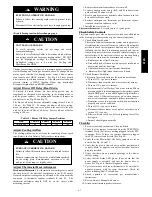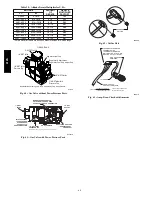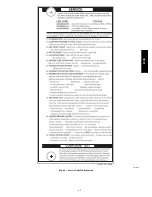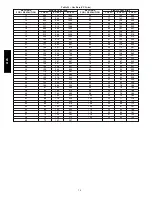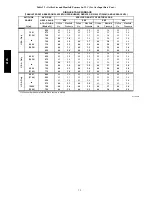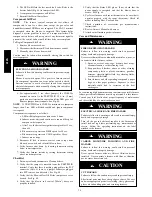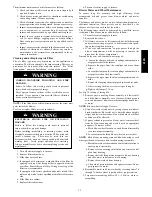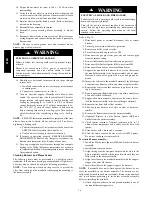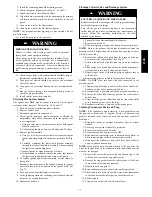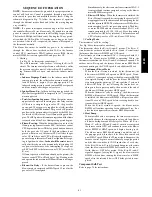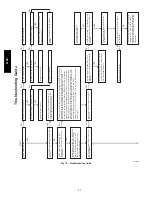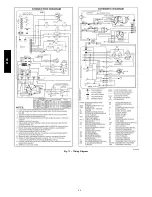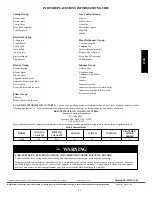
81
SEQUENCE OF OPERATION
NOTE
: Furnace control must be grounded for proper operation or
control will lock out. Control is grounded through green/yellow
wire routed to gas valve and manifold bracket screw. Using the
schematic diagram in Fig. 73, follow the sequence of operation
through the different modes. Read and follow the wiring diagram
very carefully.
NOTE
: If a power interruption occurs during a call for heat (W),
the control will start a 90--sec blower--only ON period two sec after
power is restored, if the thermostat is still calling for gas heating.
The Amber LED light will flash code 12 during the 90--sec period,
after which the LED will be ON continuous, as long as no faults
are detected. After the 90--sec period, the furnace will respond to
the thermostat normally.
The blower door must be installed for power to be conducted
through the blower door interlock switch ILK to the furnace
control CPU, transformer TRAN, inducer motor IDM, blower
motor BLWM, hot--surface igniter HSI, and gas valve GV.
1. Heating
See Fig. 40 for thermostat connections.)
The wall thermostat “calls for heat,” closing the R--to--W
circuit. The furnace control performs a self--check, verifies
the pressure switch contacts Collector Box--LPS and Hous-
ing Pressure--HPS are open, and starts the inducer motor
IDM.
a.
Inducer Prepurge Period
-- As the inducer motor IDM
comes up to speed, the collector box pressure switch con-
tacts LPS close to begin a 15--sec prepurge period. The
inducer housing pressure switch contacts HPS are ignored
until one minute after the gas valve closes.
b.
Igniter Warm--Up
-- At the end of the prepurge period, the
Hot--Surface igniter HSI is energized for a 17--sec igniter
warm--up period.
c.
Trial--for--Ignition Sequence
-- When the igniter warm--
up period is completed, the main gas valve relay contacts
GVR close to energize the gas valve GV, the gas valve
opens, and 24 vac power is supplied for a field--installed
humidifier at the HUM terminal. The gas valve GV permits
gas flow to the burners where it is ignited by the HSI. Five
sec after the GVR closes, a 2--sec flame proving period be-
gins. The HSI igniter will remain energized until the flame
is sensed or until the 2--sec flame proving period begins.
d.
Flame--Proving
-- When the burner flame is proved at the
flame--proving sensor electrode FSE, the furnace control
CPU begins the blower--ON delay period and continues to
hold the gas valve GV open. If the burner flame is not
proved within two sec, the control CPU will close the gas
valve GV, and the control CPU will repeat the ignition se-
quence for up to three more Trials--For--Ignition before go-
ing to Ignition--Lockout.
Lockout will be reset
automati-
cally after three hours or by momentarily interrupting 115
vac power to the furnace, or by interrupting 24 vac power
at SEC1 or SEC2 to the furnace control CPU (not at W, G,
R, etc.).
If flame is proved when flame should not be present, the
furnace control CPU will lock out of Gas--Heating mode
and operate the inducer motor IDM until flame is no longer
proved.
e.
Blower--On Delay
-- If the burner flame is proven, the
blower motor is energized on HEAT speed 25 sec after the
gas valve GV is energized.
Simultaneously, the electronic air cleaner terminal EAC--1
is energized and remains energized as long as the blower
motor BLWM is energized.
f.
Blower--Off Delay
-- When the thermostat is satisfied, the
R--to--W circuit is opened, de--energizing the gas valve GV,
stopping gas flow to the burners, and de--energizing the hu-
midifier terminal HUM. The inducer motor IDM will re-
main energized for a 15--sec post--purge period. The blow-
er motor BLWM and air cleaner terminal EAC--1 will
remain energized for 90, 120, 150, or 180 sec (depending
on the blower--OFF delay selection). The furnace control
CPU is factory--set for a 120--sec blower--OFF delay.
2.
Cooling Mode
The thermostat “calls for cooling.”
See Fig. 40 for thermostat connections)
The thermostat closes the R--to--G--and--Y circuits. The R--to-- Y
circuit starts the outdoor unit, and the R--to--G--and--Y circuits start
the furnace blower motor BLWM on COOL speed.
The electronic air cleaner terminal EAC--1 is energized with 115
vac when the blower motor BLWM is operating. When the
thermostat is satisfied, the R--to--G--and--Y circuits are opened. The
outdoor unit will stop, and the furnace blower motor BLWM will
continue operating on the COOL speed for an additional 90 sec.
3.
Continuous Blower Mode
When the R--to--G circuit is closed by the thermostat, the
blower motor BLWM will operate on HEAT speed. Termi-
nal EAC--1 is energized as long as the blower motor BLWM
is energized. During a call for heat, the blower BLWM will
stop during igniter warm--up (17 sec), ignition (7 sec), and
blower--ON delay (25 sec), allowing the furnace heat ex-
changers to heat up more quickly, then restarts at the end of
the blower--ON delay period at HEAT speed.
When the thermostat “calls for cooling”, the blower motor
BLWM will operate at COOL speed. When the thermostat
is satisfied, the blower motor BLWM will operate an addi-
tional 90 sec on COOL speed before reverting back to con-
tinuous--blower (HEAT speed).
When the R--to--G circuit is opened, the blower motor
BLWM will continue operating for an additional 5 sec, if no
other function requires blower motor BLWM operation.
4.
Heat Pump
When installed with a heat pump, the furnace control auto-
matically changes the timing sequence to avoid long blower
off times during demand defrost cycles. When the R--to--
Wand-- Y or R--to--W--and--Y--and--G circuits are energized
the furnace control CPU will continue to turn on the blower
motor BLWM at HEAT speed, and begin a heating cycle.
The blower motor BLWM will remain on until the end of
the prepurge period, then shut off for 24 sec then come back
on at HEAT speed. When the W input signal disappears, the
furnace control begins a normal inducer post--purge period
and the blower switches to COOL speed after a 3 sec delay.
If the R--to--W--and--Y--and--G signals disappear at the same
time, the blower motor BLWM will remain on for the se-
lected blower-- OFF delay period. If the R--to--W--and--Y
signals disappear, leaving the G signal, the blower motor
BLWM will continue running the blower motor at HEAT
speed after the selected blower--OFF delay period is com-
pleted.
Component Self-Test
Refer to page 74 for instructions.
912S

